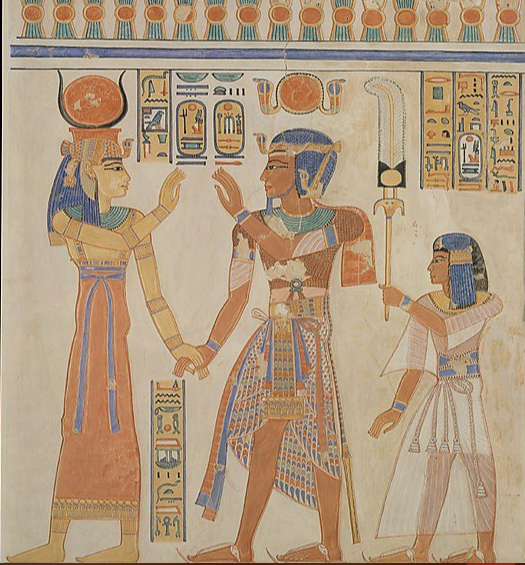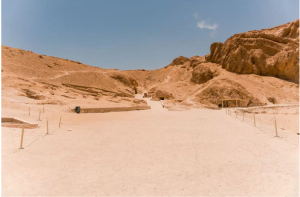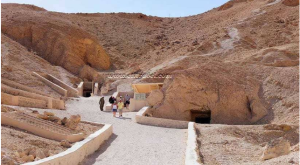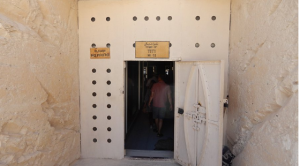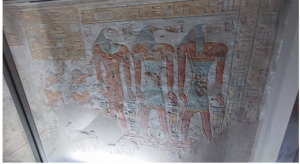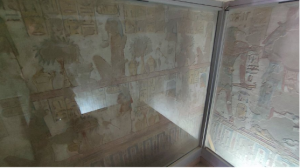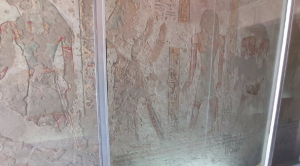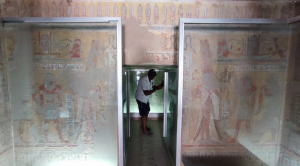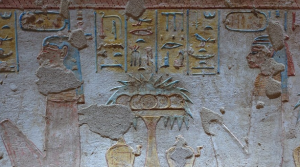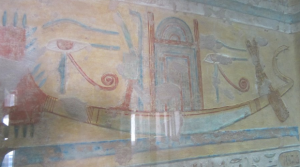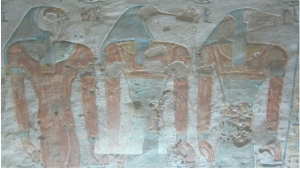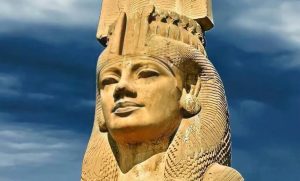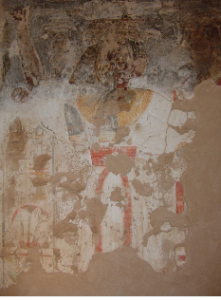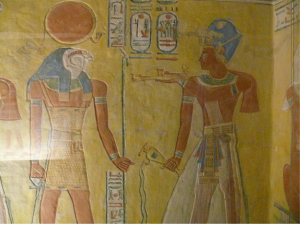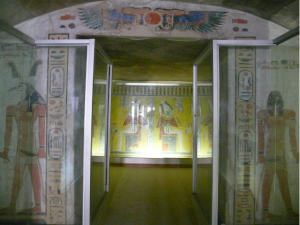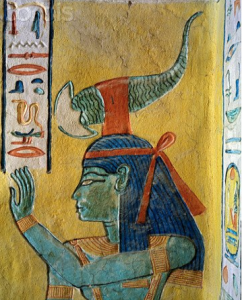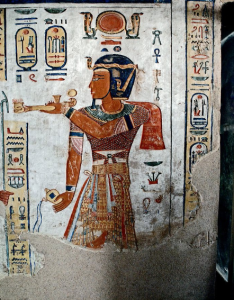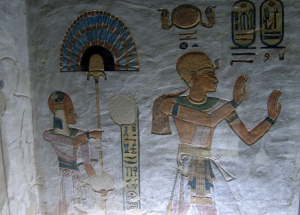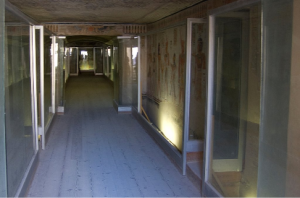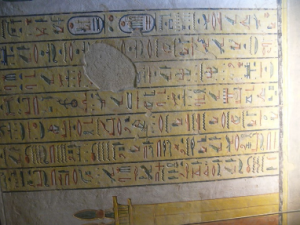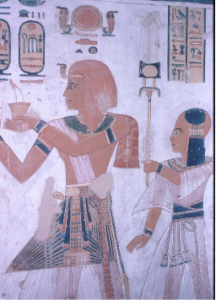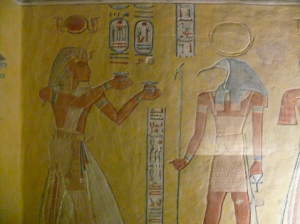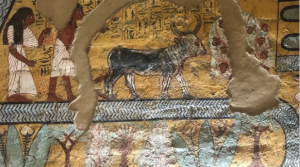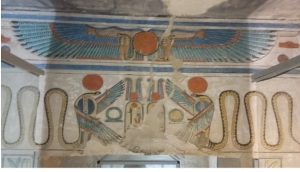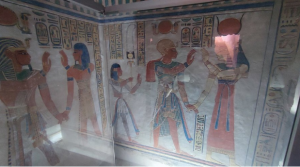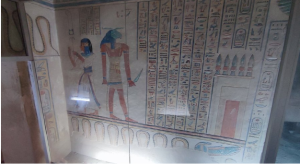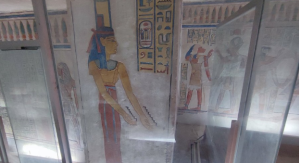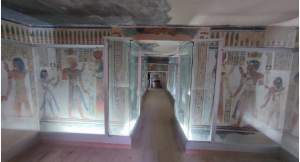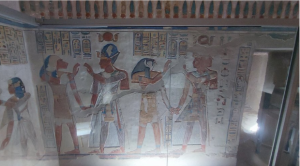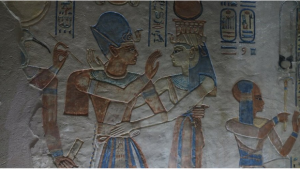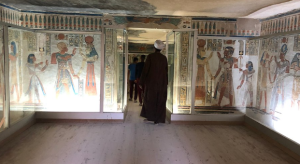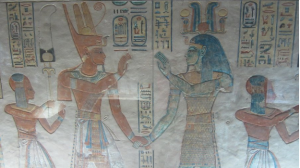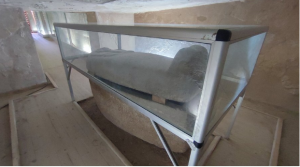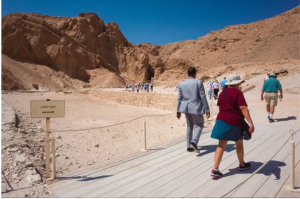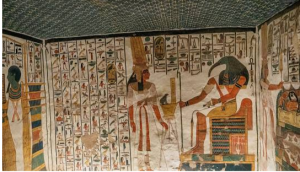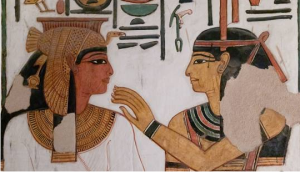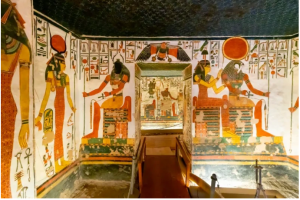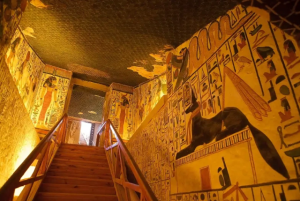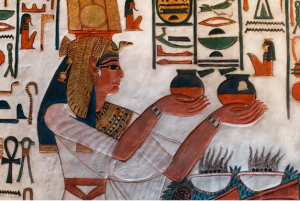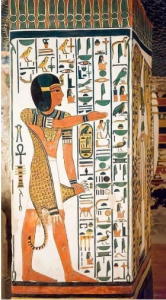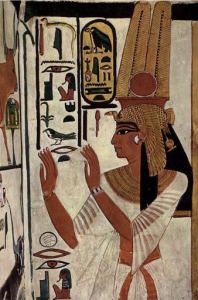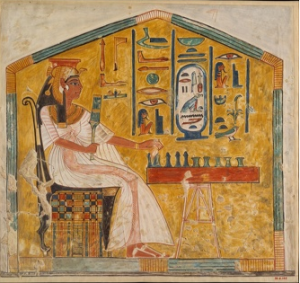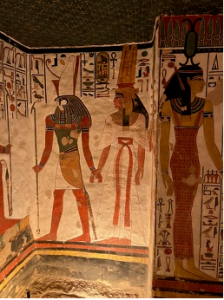The Valley of the Queens
It was designated for the burial of queens and young princes of the New Kingdom. This location was chosen because of its proximity to Deir el-Medina, the residential area for the workers of Western Thebes. The valley contains about 80 tombs, most of which are uninscribed. The tombs in the Valley of the Queens consist of two large chambers connected by a corridor, sometimes with small side chambers.
Most Important Tombs in the Valley of the Queens:
It is the tomb of Queen Nefertari, wife of King Ramses II of the 19th Dynasty. There is also the tomb of Princess Nefru Ra, daughter of Hatshepsut of the 19th Dynasty. In addition to the tombs of the princes (Amun-her-khepeshef), son of King Ramses III, and Prince Kha Em Waset (son of King Ramses III).
In the Christian Era:
These tombs, such as the tombs of Nebettawy QV60 and Henuttawy QV73, were used. They contain signs of Christian presence, and the wall scenes depicting Egyptian gods were cut with layers of plaster and Christian symbols were inscribed on them.
A general view of the Valley of the Queens
A general view of the Valley of the Queens
The Tomb of Queen Tiye
The tomb is divided into a corridor, side chambers, a hall, and then the burial chamber. Tiye is the wife of King Ramses III, and their son is the prince Khaemwaset. Her tomb is amazing in terms of the ways in which the queen is depicted. Sometimes she is portrayed as a braided girl, and in other scenes as a middle-aged woman. The tomb is distinguished by its golden inscriptions, as it contains inscriptions of the Aaru (the afterlife as pictured by the ancient Egyptians). In addition to depicting the mummification rituals and the journey of the eternal life, the tomb contains a funerary foundation, coffins, and personal belongings of the queen. The walls of Queen Tiye’s tomb depict scenes in front of various gods. The burial chamber also contains images of different animals. One of the most beautiful scenes in the tomb of Queen Tiye is her holding two stringed instruments. There is also another appearance of the god Anubis and a lion guarding the tomb of the queen. It is noticeable in the burial chamber that the ceiling is decorated with white stars painted on a gold background.
A picture of the entrance to the tomb of Queen Tiye.
A picture of the gods Heket, followed by Thoth, and behind him Horus with a falcon’s head, in front of one of the gates in the afterlife to help the deceased queen pass through the gates.
On the right, the god Thoth, with the head of an ibis, receives the queen. Then we see on the opposite wall the queen in the fields of the Aaru
The queen worships the gods in the afterlife.
A scene of offering sacrifices to the god Amun-Ra on the left.
A scene of the queen offering to the god Amun-Ra on the right, and above we see the sun’s boat in which the queen crosses to the afterlife.
A scene of the offering table.
A boat that the deceased passes through in the afterlife, with the Eye of Horus for protection, and in the middle is the place of the coffin. Note the shape of the oars.
Tiye’s tomb was abandoned and reused as a stable for donkeys, but it is still in a relatively good condition. The raised reliefs of limestone were painted pink and are very beautiful to look at.
The Tomb of Princess Meritamun:
She is the daughter of King Ramses II and his wife, Queen Nefertari. After the death of her mother, her father elevated her status in the royal palace, and for this reason, we found a huge statue of her in Akhmim town, Sohag. Some scholars believe that her father married her, and so she became a queen. The scenes in the tomb show the princess with various gods and mention that she is the daughter of the great king Ramses II. In other inscriptions, she is mentioned as the wife of King Ramses II.
A statue of Princess Meritamun in Akhmim, Sohag.
A picture from the tomb of Princess Meritamun.
The Tomb of Prince Khaemwaset:
He is the son of King Ramses III and Queen Tiye. It was discovered in 1903 AD by the Italian Schiaparelli. It contains a miniature layout of the tombs in the Valley of the Kings. There is an entrance that leads to the first hall which contains two side chambers, then the second hall, and then the burial chamber. The tomb is distinguished by its decorations and bright colors. The walls are adorned with scenes that are impressive in their beauty and distinction.
Tomb Description:
On the entrance leading to the first hall, we find the goddess Ma’at kneeling. Then we see four scenes of the prince in front of the god Ptah, the god of death. a scene of King Ramses III with his son, Prince Khaemwaset, in front of the gods Thoth, Anubis, and Ra-Horakhty.
The first side chamber:
On the wall of the entrance, we see an image of the winged solar disk, then scenes of the four protective goddesses (Isis, Nephthys, Selket, and Neith). Then scenes of Osiris with Isis and Nephthys. scenes of the deceased prince with Selket and Neith, and the four sons of Horus (who represent the canopic jars in which the organs of the deceased are placed). Then we reach the second hall and find scenes of the Book of the Gates. Then we reach the burial chamber. On the facade, we see an image of the winged solar disk, then we see the djed pillar, which is the spine of the god Osiris, on the fish of the entrance. And we see on the wall of the entrance the god Anubis with a lion to protect the entrance. Inside the burial chamber, there are scenes of the resurrection of the young prince. As well as scenes of the king worshipping the god Osiris and the four protective goddesses. also, we find a scene of the prince offering sacrifices to the god Thoth and the god Horus. After that we find the king, himself offering incense and purification rituals in front of Horus. In the tomb, many sacred coffins and many well-preserved decorations and paintings were found, which are still in good condition today. Also found in the tomb were 50 scarabs made of glass. The scarab, for the ancient Egyptians, represents resurrection
A scene from inside the tomb of Khaemwaset, with the king performing an incense ritual.
We see on the walls a scene of the god Osiris, the god of the dead. And we see above on the facade the winged solar disk.
The goddess Selket was the goddess of fertility, animals, scorpions, and magic in ancient Egypt. She was also the lady of the tent, referring to the embalming tent where the body of the deceased is prepared for the afterlife. She is depicted in the tomb of Khaemwaset with her left hand raised, wearing a scorpion symbol on her head.
The prince performing the incense ritual.
An image representing the prince as a child and the king in royal attire, wearing a crown, and a cartouche with his title appears.
A general view of the tomb from the inside.
Texts of the Book of the Dead are recorded on the inscriptions of the tomb from the inside.
An image representing the prince performing various religious rituals.
An image representing the king offering sacrifices to the god Thoth in the form of an ibis.
Scenes of the Aaru fields from the tomb of Prince Khaemwaset.
The Tomb of Prince Amun-her-khepeshef:
He is the son of King Ramses III and his wife Tiye. The prince died young; therefore, we find him depicted with a single lock of hair, which is an indication of his young age. Therefore, we find that the king is the one who performs the rituals on behalf of the prince. Despite his young age, among his titles is the holder of the royal fan on the right of the king.
Description of the tomb:
It consists of an entrance of Isis leading to a descending staircase that leads to a main chamber with a side chamber ending in a long hall that reaches the burial chamber.
The first chamber:
It contains scenes of the prince with his father, King Ramses III, who presents him to the various gods such as Isis, Thoth, Ptah, the sons of Horus, Nephthys, Shu, and Hathor. Then we see on the long hall two scenes of Isis and Nephthys, and we find scenes and texts of the Book of the Gates.
The burial chamber:
It is empty of inscriptions but contains a red granite sarcophagus.
A picture of the young prince following his father, King Ramses III, who presents him to the goddess Hathor.
Above, there is a scene of the winged solar disk and on its sides, a serpent. Then below, there is a scene of the goddesses Nekhbet and Wadjet, and above them, the solar disk protecting the names of the king found in the cartouches.
The goddess Hathor welcomes the king and his son in the afterlife.
One of the gods holds a knife to protect the prince from the small dangers in the afterlife.
The king, and in front of him are written texts that he recites so that his son may pass through the gate topped by a group of knives to pass safely.
A beautiful scene of the protective goddess Nephthys on her right, the king worships the god Thoth
The king on the right and left presents his son to the goddesses Isis and Hathor. And we see on the facade of the entrance a scene of the winged solar disk.
The king with the blue crown in front of the god Thoth with the head of a baboon” and the king holding the hand of the god Horus on the other side.
The king and his young son between the gods Thoth, the god of wisdom, and the goddess Hathor.
King Ramses III presents his son Amun-her-khepesh, who holds the fan in his hands, to the goddesses Isis and Hathor.
King Thutmose III presents his young son Amun, who holds the royal fan in his hands, to the god Amun.
The red granite sarcophagus is found in the burial chamber of the young prince.
The Tomb of Queen Nefertari:
The most beautiful royal tomb and the largest tomb in the history of Egypt. It was discovered in 1904 by the Italian Schiaparelli.
Queen Nefertari is
The beloved wife of King Ramses II. He married her when she was young, at the age of 14, and had four children with her, two sons and two daughters. The most famous of them are her son Seti and her daughter Meritamon. She had a strong personality and well educated. She was proficient in reading and languages. Her name means “the most beautiful of women”. King Ramses II built this tomb for her, which has no equal in the Valley of the Queens and is more beautiful than most of the tombs of the Valley of the Queens. He also built a temple for her in Nubia (her original homeland) and equated her with the goddess Hathor. And we note that for the first time in Egyptian history, the name of a queen who did not sit on the throne is written inside a cartouche. This indicates the extent of King Ramses II’s love for her.
The passage leading to the tomb of Queen Nefertari.
Description of the Tomb:
The tomb of Nefertari is distinguished by beautiful images of her in a white dress and a headdress of an eagle, and she is distinguished by various rings in her ears. It is also distinguished by many scenes of daily life and symbols.
1- The first hall:
We reach it from a descending staircase and find stone shelves at its entrance to place statues. On the right, we see scenes of the queen, the most important of which is her scene with the god Isis. On the left, we find her very famous scene of the queen sitting inside a cabin playing the game of senet, and in front of her is a bird with a human face (a symbol of the soul) standing on a cabin. On the western wall, a very beautiful image of the Akht (horizon) between two lions. One lion symbolizes yesterday and the other symbolizes tomorrow Then a scene of the Bennu bird, a symbol of the god Thoth in light blue, and we see in front of him a mummy riding on a bed inside a cabin between the goddesses Isis and Nephthys. And we find on the northern wall scenes of the Book of the Gates.
2- Side chambers:
At its entrance is the goddess Nekhbet, the goddess of Edfu. The first side chamber (the chamber of cloth): We find an image of the goddess Maat, the goddess of justice. Then we find the most beautiful scene of the union of the god Ra and the goddess Osiris (we see the god Ra in the form of a mummy with the head of a black ram between Isis and Nephthys). After this, the offering of a cloth robe to the god Ptah. We also find scenes of the seven Hathors (the queen worshipping the seven Hathors) and scenes from the Book of the Dead. And what is impressive is the beauty of Queen Nefertari’s clothes, her transparent white dress, earrings with lotus buds, and a wide golden bouquet, and a headdress of an eagle adorned with a solar disk.
3- The Staircase Passage:
We observe on the staircase leading to the burial chamber scenes of the four sons of Horus, and the staircase is decorated with very beautiful scenes, the most important of which is the queen offering wine to Hathor, and behind the queen is the goddess Maat, the goddess of justice. There is also a scene of a large winged serpent protecting the queen.
The Burial Chamber:
It consists of four columns, all of which have the familiar scenes of the queen with the different goddesses. There are also three side chambers. And we find on the wall’s scenes from the Book of the Gates.
On the right: Queen Nefertari in front of the offering table. And on the facade: The queen in front of the god Thoth, the god of wisdom.
The god Isis welcomes Queen Nefertari in the afterlife.
A view from the north of the goddess Hathor leading the queen in front of the god of sunrise with the head of a scarab, and on the right, a scene of the queen in front of Ra-Horakhty and Nephthys. And on the entrance appears the goddess Nekhbet, the protective goddess.
An image of the staircase and on its sides, the god Anubis is seated, and above them, the goddesses Isis and Nephthys.
An image of Queen Nefertari offering sacrifices.
One of the priests offers an offering to the god Amun and prayers for Queen Nefertari while wearing a leopard skin.
The deceased is lying on a bed between the protective goddesses Isis and Nephthys, and god Thoth in the back.
An image of Queen Nefertari worshipping the gods in a beautiful transparent dress. For the first time in Egypt, a cartouche is recorded for a queen who did not sit on the throne.
A scene of Queen Nefertari playing the game of senet.
The god Horus leads Queen Nefertari by the hand at the entrance of the tomb during her journey to the afterlife

